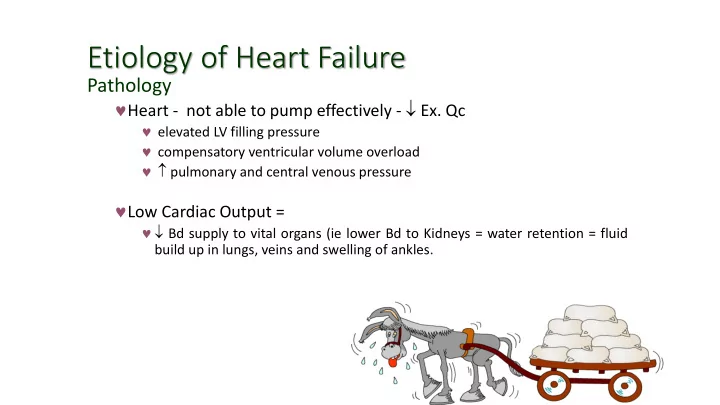

Etiology of Heart Failure Pathology ♥ Heart - not able to pump effectively - ↓ Ex. Qc ♥ elevated LV filling pressure ♥ compensatory ventricular volume overload ♥ ↑ pulmonary and central venous pressure ♥ Low Cardiac Output = ♥↓ Bd supply to vital organs (ie lower Bd to Kidneys = water retention = fluid build up in lungs, veins and swelling of ankles.
Volume Pressure Loss of Impaired Overload Overload Myocardium Contractility Heart Failure ↑ End Systolic Volume ↓ Cardiac Output ↑ End Diastolic Volume Hypoperfusion Pulmonary Congestion
Heart Failure Classifications • Systolic: Impaired contractility/ejection (HFREF) • Diastolic: Impaired filling/relaxation (HFPEF) 30% (EF > 40 %) (EF < 40%) 70% Diastolic Dysfunction Systolic Dysfunction
New York Heart Association Functional Classification Class I: No symptoms with ordinary activity Class II: Slight limitation of physical activity . Comfortable at rest, but ordinary physical activity results in fatigue, palpitation, dyspnea, or angina Class III: Marked limitation of physical activity. Comfortable at rest, but less than ordinary physical activity results in fatigue, palpitation, dyspnea, or anginal pain Class IV: Unable to carry out any physical activity without discomfort. Symptoms of cardiac insufficiency may be present even at rest
Meds Diuretics • Relieves fluid retention; ↑ exercise tolerance ACE Inhibitors • Prevents formation of potent vasoconstrictor (angiotension II) = ↓ SVR Beta-Blockers Digoxin Enhances inotropy of cardiac muscle
Exercise HF - Exercise Prescription -Aerobic Intensity 50-80% of peak VO 2; 40-60% HRR or VO 2 peak RPE 12-13 (20 point scale) 4-6 (10 point scale) Duration Daily = 20-30 minutes g Goal = 150min/week Prolong warm up and cool down Low intensity long duration interval exercise 1:1 or 1:2 work:rest ratio (e.g., 1-2 min/interval) Frequency 3-5 days/week Modes No specific recommendation something enjoyable Modes which facilitate easy monitoring Resistance training Hi Reps / lower intensity – bands machines and free weights Flexibility Tai Chia, yoga etc. AHA Statement – Circ. 2003
Aerobic Interval Training in CHF
WHAT ABOUT AEROBIC INTERVAL TRAINING? METABOLIC RESPONSES Higher work intensity = greater total work, particularly in those with reduced functional capacities. La accumulation is ↓ compared to continuous work = less fatigue. Ex intensity, total work performed, and caloric expenditure can be significantly ↑ using interval training.
Aerobic Interval Training in CHF 25 * # 20 Peak VO 2 (ml/kg/min) * 15 Pre 10 Post 5 0 NT CON INT (* p,.05 vs. pre; #, p<.05 vs. NT and CON) Wisloff et al 2007
Aerobic Interval Training in CHF Figure 3-Differences (in percent) of work rate and exercise parameters during interval training based on reference index (100 = intensity level at 75% of peak ·VO2) (values are mean ± SEM). From: MEYER: Med Sci Sports Exerc, Volume 29(3).March 1997.306-312
Sign gns o of E Exerti tional I Intolerance i in C CHF HF P Patient • Persistent fatigue lasting more than 24 hours • Worsening of Ex tolerance or dyspnea @ rest/exertion over previous 3-5 days • Significant ischemia @ low P.O. (<2 METs) • Nocternal dyspnea Unexplained weight gain> 2kg ↑ in body mass over previous 1 – 3 days • • Swelling in the periphery (check sock line) • Supine resting HR > 100 bpm • Acute systemic illness or fever ↓ SBP with exercise • • post Ex. Hypotension • Complex ventricular arrhythmias @ rest or with exercise From the working group on cardiac rehabilitation & exercise physiology and the working group on heart failure of the European Society of Cardiology 2001
WHY HY DO DON’T W WE DO DO IT? General Healthy Populations • 63%, falling to 50% @ 12 months Martin & Sinden 2001 Cardiac Populations Only 15-25% of eligible patients participate! Am Heart J 2006; 152:835-841 CHF = 80% view exercise as important but only 39% do it. van der Wal MHL et al., Eur Heart J 2006 61% of CR patients consider adhering to exercise more difficult relative to other recommendations Evangelista LS et al., Am J Cardiol 2001
Daily Activity - Why Should We Care?- Background • Daily PA closely linked to exercise capacity & HF clinical status/prognosis (Belardinelli et al , 1999, Jehn et al 2009; Jehn et al 2011) • Adherence to exercise training is a problem for HF patients Piepoli MF et al., Eur J Heart Failure 2011; 13(4):347-357. Conraads VM, et al., Eur J Heart Failure 2012;14(5):451-458. van der Wal MH, et al., Eur Heart J. 2010;31(12):1486-1493 • Daily activity may be easier than exercise to fit into daily life • Assessing daily PA = valuable in identifying patients at high risk and provides an objective measure of incapacity during normal daily life Walsh JT, et al., Am J Cardiol., 1997; 15;79(10):1364-9 . • Stronger index of mortality than lab based exercise testing variables such as VO 2peak and Exercise time (Seo et al., 2008)
Steps • Healthy older adults take 6,500-8,500/day Ayabe et al Cir J 2008; 299-303 • Chronic illnesses – take 3,500 – 5,500 steps/day Tudor-Locke et al., Res Q Exerc Sport 2001;72(1):1-12 • CHF patients = 3,500-4,300 Walsh JT, et al Am J Cardiol. 1997;79:1364-1369 Houghton AR, et al., Eur J Heart Fail; 2002;4:289-295 Hoodles DJ, et al., Int J Cardiol 1994; 43:39-42 • <3,750 steps per day related to increased mortality Walsh JT, et al., Am J Cardiol., 1997; 15;79(10):1364-9; (Seo et al., 2008)
Discussion HF patients are usually assessed using their exercise capacity but the variance in their daily PA should be considerable . (Contje 2013, Metra 1998) No difference in daily activity between systolic and diastolic HF across all activity intensities Daily Activity of HF patients = mainly in the mild intensity range, Our HF sample averaged ∼ 3000 steps / day literature reports about 7000 steps / day. (Contje 2013,Izawa 2012, Jehn 2009)
Daily Activity Continuum in CRT patients 4% 4% 18% 16% 21% 80% 78% 70%
The End Thank you
Recommend
More recommend